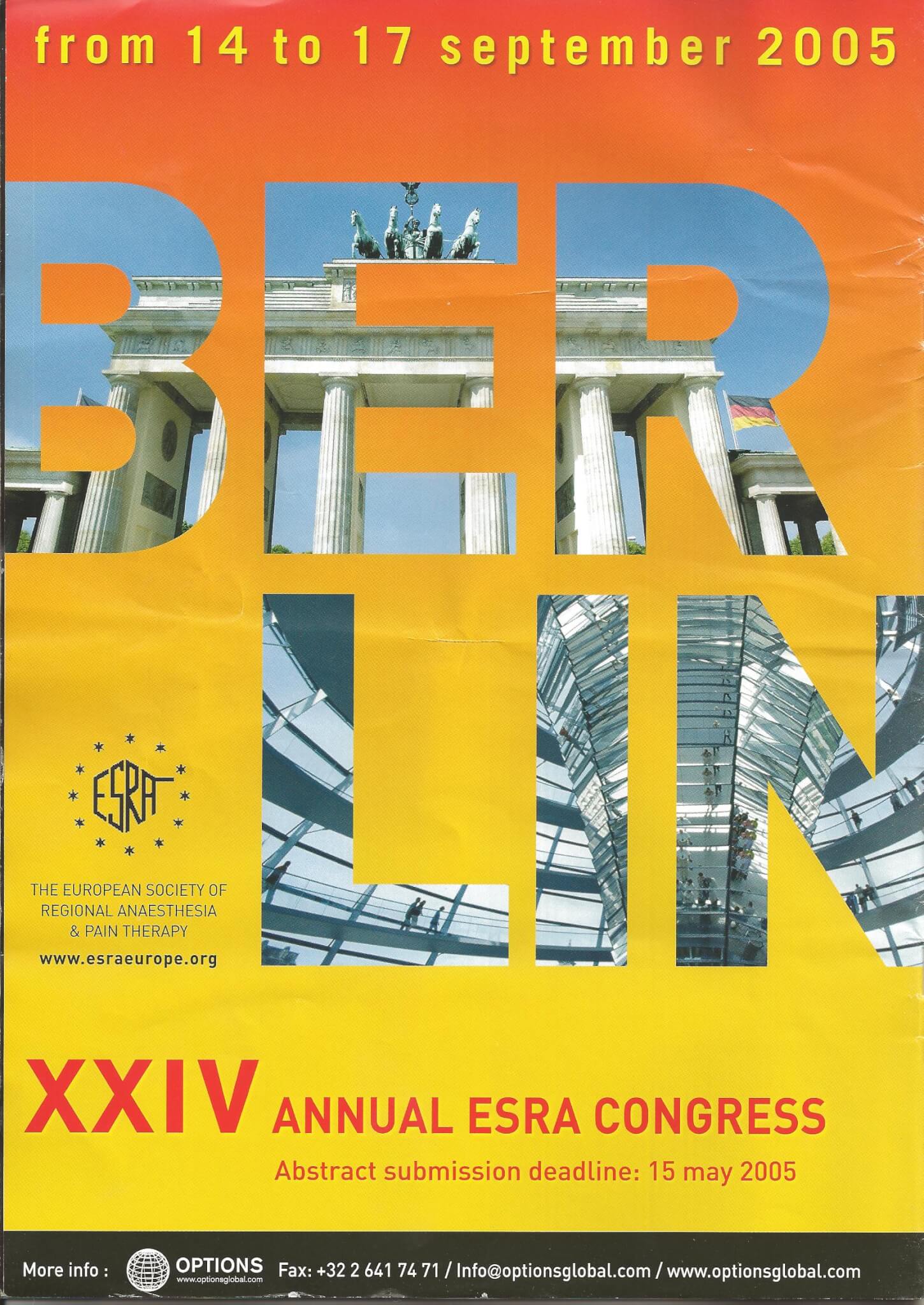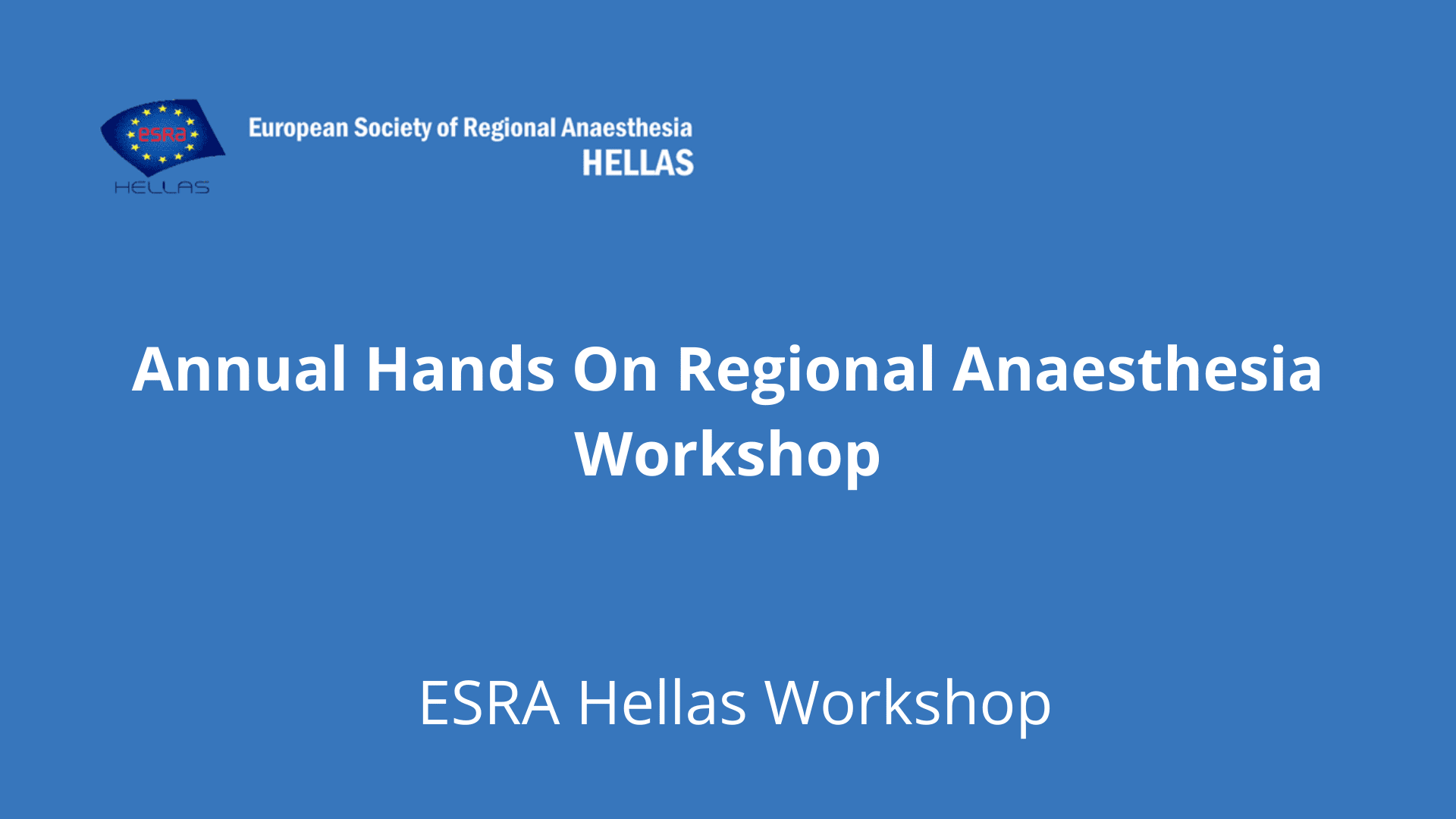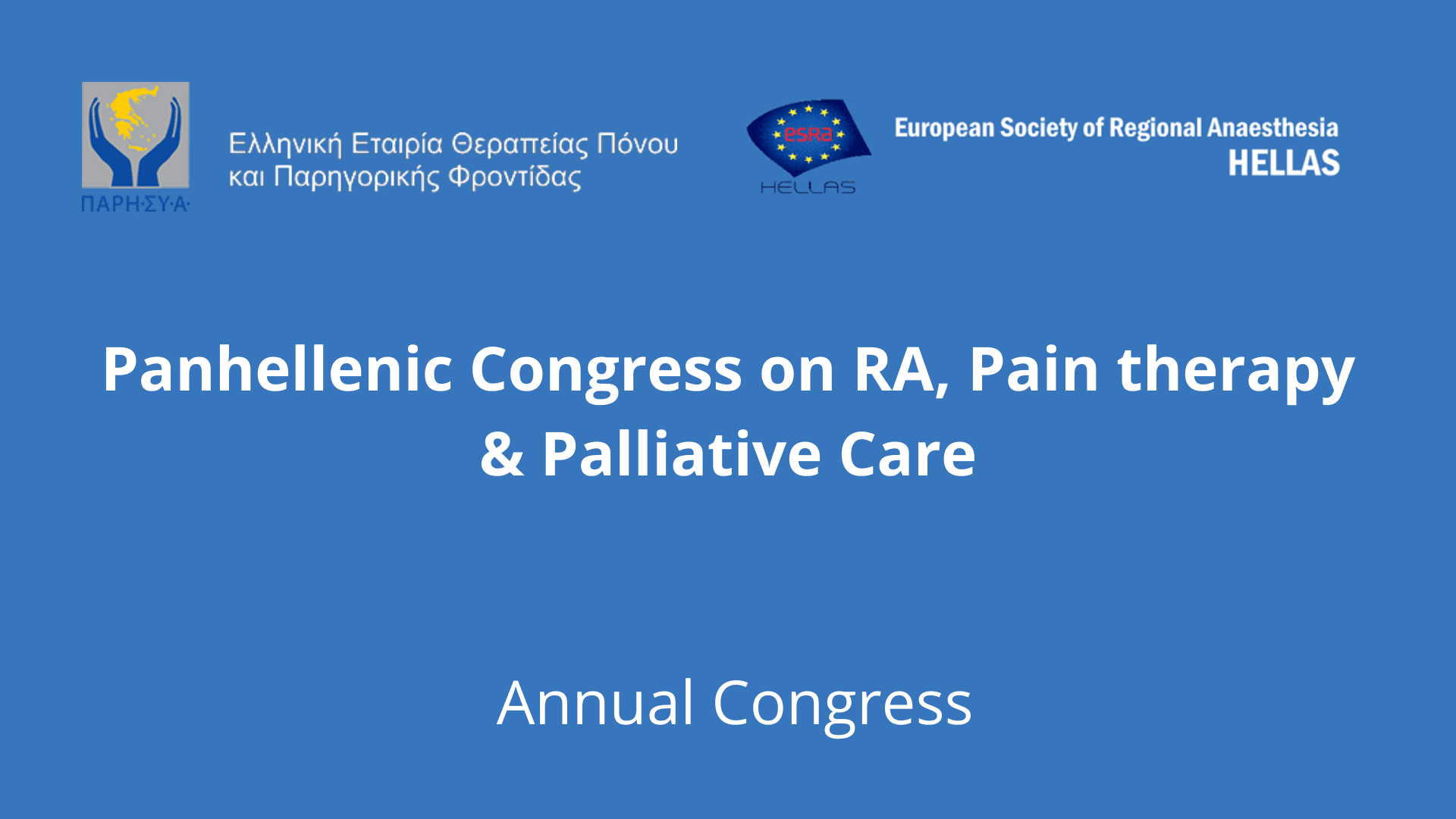REGIONAL ANAESTHESIA AND CARDIAC DISEASE

ESRA Highlights
24th Annual ESRA Congress
September 14 – 17, 2005, Berlin, Germany
Congress Highlights
REGIONAL ANESTHESIA AND CARDIAC DISEASE
How does it influence practice?
Eriphili Argyra
Faculty of Medicine, University of Athens, Greece
for full text in pdf form click here.
Anaesthesiologists have debated for many years whether regional anesthesia (RA) is better than general anaesthesia for patients suffering from cardiac desease. Many studies in this area are weak in experimental design and therefore have not produced any definite answers. Due to the rarity of some situations like valvular disease, the literature offers many anecdotal cases but not controlled studies; and guidelines are needed to sum up best evidence for these challenging situations. Untill then we must rely more on the understanding of the pathophysiology of cardiac disease, of surgical needs and of the effects of the anaesthetic technique in every different situation.
Regional anaesthesia and Ischemic decease
The application of regional analgesia as an adjunct to general anesthesia continues to enjoy enthusiasts among clinicians.The succesfull use of TEA for the treatment of angina and ischemic heart desease and improved analgesia after thoracotomy have prompted use of of TEA for cardiac surgery. High Thoracic Epidural Anaesthesia/Analgesia for coronary artery bypass graft surgery promotes perioperative analgesia and attenuates the stress response to surgery; it provides effective pain relief for patients with unstable angina and myocardial infarction.[1] The beneficial affects of local anaesthetic administration through a high thoracic epidural catheter in patients with severe angina who are not canditates for surgical revascularization have been documented [2]. Surgery of the coronary arteries in patients with co morbid conditions is fraught with difficulties. Minimally invasive direct coronary artery bypass surgery and conscious off-pump coronary artery bypass surgery (COP CAB) has been performed in conscious patientswith acceptable results [3]. One must never underestimate that, although general anaesthesia is considered safe, it is not without complications.
Is TEA cardioprotective?
In several animal studies, it has been shown that Thoracic Epidural Anaesthesia (TEA) may redistribute myocardial blood flow in favor of subendocardial layers at risk of ischemic events and may reduce the size of experimentally induced myocardial infarction. [4][5] A protective effect of TEA against arrythmogenesis has been seen in animal [6] as well as in human studies.[7] In an unblinded analysis of 400 patients undergoing CABG, Scott et al [8] assesed the postoperative impact of TEA using 0.5% bupivacaine and clonidine epidurally. Among other findings, their results indicate a reduction of supraventricular arrythmias. Lower catecholamine levels and slower heart rates after CABG in TEA treated patients were also previously reported.
The effect of HTEA on biochemical or ECG markers οf myocardial ischemia or infarction is not clear yet. Ιn a prospective randomized controlled trial for elective CABG surgery Barrington et al [9] found that HTEA had no effect on the release of troponin I, whereas HTEA improved time to tracheal extubation and analgesia. In this study according to authors, infusion of ropivacaine 0.2% did not maintain a dense sympathetic block compared with bupivacaine 0.75% in the study by Loick et al [10], who reported reduced troponin T release with HTEA. However, the same results were noted by Priestley et al, who used ropivacaine 1% and also found no effect on troponin levels with HTEA. Despite the theoretical advantages of HTEA, factors such as technical difficulty in grafting and myocardial protection during the ischemic period may have a more significant effect than HTEA on troponin release.
The same may not be the case with lumbar epidural anaesthesia. Above the level of blockade, there is usually a compensatory increase in sympathetic activity, and this may lead to coronary vasoconstriction and reduction in coronary blood flow. Any uncorrected hypotension from regional anaesthesia may compromise coronary perfusion and precipitate myocardial ischemia. to Saada et al [11] actually have shown that that while lumbar EA improved segmental myocardial wall motion (SWM) in normal patients, probably by decreasing afterload, it actually worsened SWM in patients with pre-existing CAD.
Countering the potential cardioprotective effect of TEA is the possible risk of hypotension secondary to bradycardia and reduced sympathetic tone. Several studies in CADG patients have shown larger intraoperative vassopressor requrements in TEA-treated patiets compared with controls [12] [13], and the impact of hypotension on the incidence of myocardial ischemia in patients with critical coronary stenosis cannot be ignored. This aspect of the application of TEA during CABG requires further concideration[14].
Regional anaesthesia and valvular desease
Patients with significant aortic stenosis (AS) who present for noncardiac surgery offer a unique challenge to the anaesthesiologist. It is the only valvular lesion identified as a significant risk factor for noncardiac surgery.Specific hemodynamic goals must be maintained to avoid serious, even fatal, complications. Traditionally, neuraxial blockade has been considered contraindicated in these patients because the sudden and potentially profound decrease in systemic vascular resistance may precipitate a life-threatening compromise in coronary perfusion.However, certain neuraxial techniques, such as continuous spinal and epidural anaesthesia, can be tailored to minimize this effect.
Does evidence exist in the literature to support the traditional view that spinal and epidural anaesthesia are contraindicated in patients with AS[15]? No randomized or prospective clinical trials are available in the literature. Two retrospective series evaluating the risk of noncardiac surgery in patients with AS were found. In 1 series of 48 patients[16],22 had general anaesthesia, 25 had local anaesthesia, and 1 had a neuraxial blockade (spinal anaesthetic); significant hypotension without major sequelae occurred intraoperatively in 5 patients including 4 patients receiving general anaesthesia and the one patient who had the spinal anaesthetic. The second series[17] represented 2 neuraxial techniques (continuous spinal anaesthetics) and 26 general anaesthetics; although hypotensive episodes occurred during 16 of the 28 procedures and 2 perioperative deaths were recorded, the authors did not differentiate by anaesthetic type. Seven case reports were foundon successful use of regional anaesthesia in 10 patients with AS from 1993 to 2003, including 1 case report of an aortic valve replacement under epidural anaesthesia in a lightly sedated, spontaneously ventilating patient. The current evidence in the literature lacks the scientific validity provided by randomized clinical trials. The best information available is a few anecdotal observations that neuraxial anaesthesia has been administered successfully in patients with significant AS. No contradictory evidence was found (i.e., adverse outcomes with neuraxial blockade in the same patient population). Any conclusions can only be based in observation and in clinical understanding of the pathophysiology of AS and the physiologic perturbations of neuraxial anaesthesia.
A precipitous andmarked decrease in afterload can result in profoundhypotension and myocardial ischemia in patients with severeaortic insufficiency. Cardiovascular collapse and death hasbeen described in a woman with aortic regurgitation and pre-eclampsiawho received a single bolus of 18 ml of epidural bupivacaine0.5
There is little data in the literature to guide the anaestheticmanagement of patients with severe pulmonary valvedisease. Epidural anaesthesia, using incremental injectionsof bupivacaine 0.5%, has been successfully used for Caesareandelivery in a woman with Watson’s syndrome who had pulmonarystenosis[18]. Analgesia for labour and delivery has been providedwith an intrathecal sufentanil infusion, and a 15 mg bolusof lidocaine 1% for vacuum extraction, in another parturientwith isolated severe pulmonary stenosis.[19] % (after a 2 ml test-dose of the same solution) forCaesarean delivery.
Various case reports referring to rheumatic mitral stenosis (MS) in pregnant women are found in the literature. The ideal labor analgesia and cesarean anesthetic for this population, based on patient expectation, severity of disease, safety, and morbidity outcomes remains controversial. A carefully and gradually titrated lumbar epidural analgesia or CSEA, with consideration to optimize preload, afterload, heart rate, and rhythm, can be used for analgesia and anesthesia in nearly all patients with MS[20] However, when contraindications to regional anesthesia are present, general anesthetic can be safely administered for cesarean delivery, but care should be used to avoid the significant increases in heart rate, SVR, and PVR commonly associated with induction and emergence. With either regional or general anesthesia techniques, invasive monitoring should be reserved for patients with severe disease.
Hypertrophic obstructive cardiomyopathy (HOCM) is a rare, genetically transmitted disease that places patients at significant risk of sudden cardiac death. Patients with HOCM develop an idiopathic myocardial thickening that usually predominates in the interventricular septum. The enlarged septum can result in left ventricular outflow obstruction leading to angina pectoris, syncope, tachydysrhythmias, and congestive heart failure. Though morbidity and mortality during normal activity is low, HOCM patients have a higher incidence of congestive heart failure and other cardiac events when placed under surgical stress. Data describing the successful anaesthesia management of HOCM in noncardiac surgery is limited.
Anaesthetic goals for the HOCM patient have typically been directed towards achieving conditions that favour the hypertrophic heart, such as depressed myocardial contractility, normal or increased systemic vascular resistance (SVR), and increased left ventricular volume. Compared to general anaesthesia, regional anaesthesia techniques can provide superior postoperative analgesia, decreased surgical stress response, and a reduction in postoperative nausea and vomiting which can benefit HOCM patients. Neuraxial anaesthetic techniques, however, are generally avoided in HOCM patients requiring thoracic surgery because of the sympathectomy and subsequent decrease in SVR frequently induced. Paravertebral blocks (PVB) were used in a HOCM patient who presented for partial mastectomy with lymph node dissection. Continuous spinal anaesthesia (CSA) was the anaesthetic technique chosen for a patient, at 33 weeks’ twin gestation previously diagnosed with peripartum cardiomyopathy (PPCM), now presenting in congestive failure requiring operative delivery[21]. It was a successful anaesthetic that also markedly reduced the patient’s symptoms.
Regional anaesthesia and cardiac outcome
There is a still going discussion on the effects of Regional anaesthesia on perioperative outcome. In a meta-analysis of eleven randomized controlled trials of 1173 patients RA was associated with lower rate of myocardial infarction that just reached statistical significance. Subgroup analysis showed that thoracic epidural analgesia was associated with a decrease in infarction rate compared with systemic analgesia (p=0.04) but lumbar epidural analgesia had no effect.[22] Another meta-analysis[23 of the effect of neuraxial blockade, epidural or spinal on postoperative morbidity, assessed 141 trial of 9559 patients and concluded that the overall 30 day mortality was decreased signifficantly (30%) by neuraxial blockade. They reported evidence of an improvement not only in major morbidity but even on mortality. There has been a lot of scrutiny on the results of the above mentioned study concluding that RA only improved mortality in patients undergoing orthopedic surgery and that use of general anaesthesia negated the beneficial effect on mortality of RA alone. Although thoracic epidural and spinal analgesia significantly improved mortality, lumbar epidural analgesia was ineffective.
Another meta-analysis comparing GA versus RA for hip fracture surgery examining 15 trials of 2162 patients showed decreased mortality in the RA group 6.4% RA, versus 9.4% in the GA group. The result not surprisingly was not sustained after 3, 6 and 12 months[24].
Recent randomized controlled trials[25] [26] [27] failed to show any major advandage in outcome of combined RA versus GA. This might reflect the recent improvents in GA which have been sufficient to catch up to the standards set for regional anaesthesia in the 1980s and early 1990s[28].
According to an editorial by de Leon-Casasola[29], the principals of an epidural technique designed to improve pulmonary and cardiac outcome were not fulfilled in these studies. It is not clear if the patients had a complete sensory block throughout surgery; if the concentration of the inhaled anaesthetic was larger of 0.5 MAC and there was a frequent use of opoids during surgery, the study is not comparing an epidural technique with general anesthesia but two general anesthesia techniques.
The activation of the neuroendocrine response results in high levels of norepinephrine that stimulates coronary endothelial production of nitric oxide resulting in paradoxic vasoconstriction (vasospasm) in patients with AHD. Thus for a patient to derive a cardioprotective effect from a perioperative epidural technique, the catheter must be inserted in the high thoracic region. Moreover, a local anaesthetic must be administered both during and after surgery in a continous fashion, and for at least 72 hours, conditions not clearly met in the above mentioned studies.
Conclusions
In conclusion, cardiac disease does not preclude regional anesthesia, but the anesthetic management must be based on individual assessment of cardiac function and reserve, and an anticipation of the impact of selected anesthetic technique (regional or general) on cardiac performance. Regional techniques based on that philisophy can lead the patient or parturient through surgery and postoperative course successfully. As de Leon-Casasola pointed out in his thoughful editorial, don’t throw away those Tuohy needle s and epidural catheters just yet.
References






